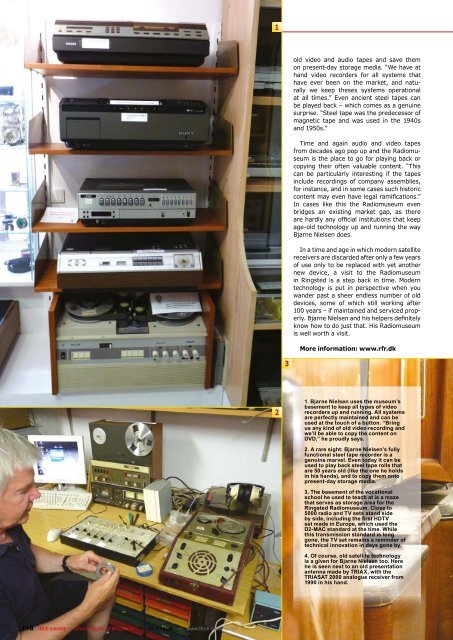C'est tellement facile: - TELE-satellite International Magazine
C'est tellement facile: - TELE-satellite International Magazine
C'est tellement facile: - TELE-satellite International Magazine
You also want an ePaper? Increase the reach of your titles
YUMPU automatically turns print PDFs into web optimized ePapers that Google loves.
118 <strong>TELE</strong>-<strong>satellite</strong> — Global Digital TV <strong>Magazine</strong> — 10-11/2010 — www.<strong>TELE</strong>-<strong>satellite</strong>.com<br />
1<br />
2<br />
3<br />
old video and audio tapes and save them<br />
on present-day storage media. “We have at<br />
hand video recorders for all systems that<br />
have ever been on the market, and naturally<br />
we keep theses systems operational<br />
at all times.” Even ancient steel tapes can<br />
be played back – which comes as a genuine<br />
surprise. “Steel tape was the predecessor of<br />
magnetic tape and was used in the 1940s<br />
and 1950s.”<br />
Time and again audio and video tapes<br />
from decades ago pop up and the Radiomuseum<br />
is the place to go for playing back or<br />
copying their often valuable content. “This<br />
can be particularly interesting if the tapes<br />
include recordings of company assemblies,<br />
for instance, and in some cases such historic<br />
content may even have legal ramifications.”<br />
In cases like this the Radiomuseum even<br />
bridges an existing market gap, as there<br />
are hardly any official institutions that keep<br />
age-old technology up and running the way<br />
Bjarne Nielsen does.<br />
In a time and age in which modern <strong>satellite</strong><br />
receivers are discarded after only a few years<br />
of use only to be replaced with yet another<br />
new device, a visit to the Radiomuseum<br />
in Ringsted is a step back in time. Modern<br />
technology is put in perspective when you<br />
wander past a sheer endless number of old<br />
devices, some of which still working after<br />
100 years – if maintained and serviced properly.<br />
Bjarne Nielsen and his helpers definitely<br />
know how to do just that. His Radiomuseum<br />
is well worth a visit.<br />
More information: www.rfr.dk<br />
1. Bjarne Nielsen uses the museum’s<br />
basement to keep all types of video<br />
recorders up and running. All systems<br />
are perfectly maintained and can be<br />
used at the touch of a button. “Bring<br />
us any kind of old video recording and<br />
we’ll be able to copy the content on<br />
DVD,” he proudly says.<br />
2. A rare sight: Bjarne Nielsen’s fully<br />
functional steel tape recorder is a<br />
genuine marvel. Even today it can be<br />
used to play back steel tape rolls that<br />
are 50 years old (like the one he holds<br />
in his hands), and to copy them onto<br />
present-day storage media.<br />
3. The basement of the vocational<br />
school he used to teach at is a maze<br />
that serves as storage area for the<br />
Ringsted Radiomuseum. Close to<br />
5000 radio and TV sets stand side<br />
by side, including the first HDTV<br />
set made in Europe, which used the<br />
D2-MAC standard at the time. While<br />
this transmission standard is long<br />
gone, the TV set remains a reminder of<br />
technical innovation in days gone by.<br />
4. Of course, old <strong>satellite</strong> technology<br />
is a given for Bjarne Nielsen too. Here<br />
he is seen next to an old presentation<br />
antenna made by TRIAX, with the<br />
TRIASAT 2000 analogue receiver from<br />
1990 in his hand.

















